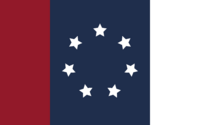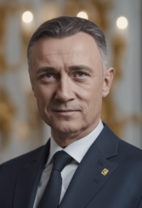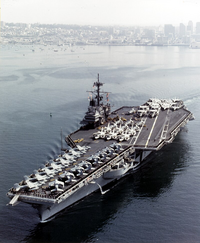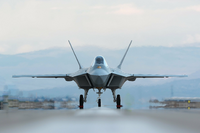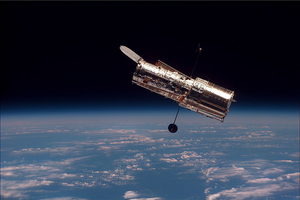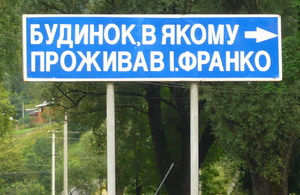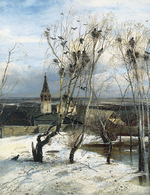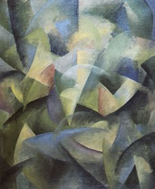Khraelyia
Federal Republic of Khraelyia Федеративна Республіка Храелія Federatyvna Respublika Khraeliya (Khraelyi) | |
|---|---|
|
Motto: "Мир, Рівність, Батьківщина" Peace, Equality, Fatherland | |
|
Anthem: "State Anthem of Khraelyia" | |
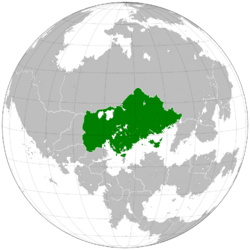 Map of Khraelyia on the globe (dark green) | |
| Capital | Soliriv |
| Largest City | Bochvohrad |
| Official languages | Khraelyi |
| Recognised regional languages | Reanhark |
| Ethnic groups (2020) |
|
| Religion |
|
| Demonym(s) | Khraelyi |
| Government | Federal Parliamentary Republic |
| Viktor Novikov | |
| Olha Polyakova | |
| Artur Hrytsyuk | |
| Legislature | Bicameral Legislature |
| Senate | |
| National Assembly | |
| Establishment | |
• Khraelyi Confederation | 1801-1847 |
• Unification of the Kingdom of Khraelyia | 1846-1853 |
| 1901 | |
| 1909-1913 | |
| 1919-1924 | |
| 1941-1948 | |
| 1995 | |
| Area | |
• | 9,336,907 km2 (3,605,000 sq mi) |
• Water (%) | 8.5 (2013) |
| Population | |
• 2024 estimate |
|
• 2020 census | 362.24 Million |
• Density | 38.8/km2 (100.5/sq mi) |
| GDP (PPP) | 2024 estimate |
• Total |
|
• Per capita |
|
| GDP (nominal) | 2024 estimate |
• Total |
|
• Per capita |
|
| Gini (2020) |
medium |
| HDI (2020) |
very high |
| Currency | Khraelyi Dollar ($) (KKR) |
| Time zone | UTC-7 |
• Summer (DST) | UTC-6 |
| Date format | Day, month, year • Year, month, day |
| Driving side | right |
| Calling code | +40 |
| ISO 3166 code | KH |
| Internet TLD | .kh |
|
Website www.khraelyia.kh.gov | |
| |
Khraelyia[a], officially the Federal Republic of Khraelyia, and commonly referred to as just the Republic, is a country in north-central Verdantis. It is the second most populous country on the continent, as well as the third largest by territory, following the CSCR and Kardovija. Khraelyia is situated along the large Tserov Basin, with the Grindgat Sea to the south, the Sarakhiv Mountains to the north, and the Blahoveshnyi Mountains to the west. The nation's capital and seventeenth-largest city is Soliriv, whilst the largest financial sectors can be found in Lisivka and Bochvohrad. Khraelyia borders the Sofíae Commonwealth to the north, the Republic of Oselia to the east, the Twin Monarchies to the west, and Republic of Chzeknye and Kirkassag Republic to the southwest. All of Khraelyia's land equates to 9,336,907 square kilometers (3,605,000 square miles). With a population of 372.49 million as of 2023, Khraelyia is one of the most populous countries in the world.
Various proto-Khraelyi tribes inherited regions of southern Khraelyia during the First Age of Man, especially during the Classic Khraelyi Era. A region dubbed Khrali-zemli was first documented in 330AD, and a Khraelyi kingdom was seen as early as 456CE, before falling by the 8th century due to continued infighting. After hundreds of years of essential anarchy with hundreds of smaller Khraelyi kingdoms, the majority of south-central Verdantis identified as a form of Khraelyi. Khraelyia as a national identity had first sprouted as early as the mid 18th century, followed by the formation of the Khraelyi Confederation in 1801.
Once the Confederation was formed, there were almost instant attempts for power within it. In 1846, multiple powers within modern-day Khraelyia would attempt to overthrow Tserovite rule. However, these attempts would ultimately culminate in the unification of Khraelyia in 1853, under king Mykhail IV. Using his newfound power, he ushered in a Khraelyi golden age. In 1873, a Khraelyi fleet compelled the Kingdom of Estry to end policies of isolation, cementing a form of Khraelyi hegemony over the Ebirian peninsula. Khraelyia also expanded her colonial ambitions, creating and expanding colonial states during the late 19th century.
Following almost fifty years of monarchist rule as well a major famine, angered by the ineffective governance by the king, democrat-led rebellions and strikes forced Khraelyia into a more democratic rule of law, which has stood until this day. In 1909, Khraelyia got involved in the Grindgat Crisis. In 1941, Khraelyia was invaded by numerous nations in a surprise attack. Despite initial advances occupying a significant portion of southwest Khraelyia, it was fully able to regain lost territories by 1948.
Khraelyia has been described by many modern politicians as the leader of the free world, with the largest economy by far as well as near-global presence militarily. It is a global leader in multiple scientific institutions as well as medical research, while also being a top exporter worldwide. As a developed country, it offers advanced social insurance, universal healthcare, and tuition-free college. Khraelyia is the leader of the Organization of Free Seterran Nations, and is a highly respected member of the World Mandate Organization. Khraelyia is officially regarded as a Nuclear Weapon State, along several others.
Etymology
The name of Khraelyia has no definite origin, however Proto-Kardovij texts have first based the term from the word Krajina, which meant 'borderland'. Nevertheless, the term evolved with the introduction of Khraelyi peoples, whom used the term Khralina alongside Krajina. By the 9th century, the terms had combined into Khraljia, meaning 'border', or 'edge'. The term further evolved by the 16th century, becoming Khraeljia, before being simplified in the reform of the Khraelyi language in 1821, finally becoming Khraelyia.
History
According to archeological findings within Khraelyia, the first humans were present in Khraelyia at least 400,000 years ago. The first non-modern human fossil was discovered in the Dovhoshykha Plateau. Similarly dated findings of human evidence can be found in the Lisivka Lowlands, and shallow regions of the Pyatyvoda Bay. The first recorded events of history within Khraelyia were early cave paintings found in the Sarakhiv mountains, dating back to 4500 years ago.
The first named tribes to inhabit Khraelyia were the proto-Kardovij, a split from the Proto-Indo-Verdantisans, whom migrated north from modern-day Mestra and Remania. Evidence found from exhumed grave sites and former ancient cities found their arrival to be roughly 3500 years ago. A split within the proto-Kardovij would become early Khraelyi tribes, with the most predominant being the Khraelyi-Rus, the predecessor of modern Khraelyi peoples. The formation of early societies would begin with the Siverschyna River Society, a civilization which lasted from 3400BCE to roughly 2950BCE.
Golden Age of Liokhivtsi
The initial formation of the Khraelyi Rus' is uncertain, however written record of the existence of the nation is estimated to begin around 456CE. The state included a vast majority of Khraelyia, Zaduna, portions of Daejian and the Sofíae Commonwealth. According to studies performed by a multitude of Khraelyi System universities, the early Rus' was predominantly early-Khraelyi peoples, with a significant minority of Vohylt peoples. Nevertheless, the Khraelyi Rus' was composed of several principalities ruled by the interrelated Kniazes, or princes whom often fought each other for control of Liokhivtsi, the initial capital.
During the 6th and 7th centuries, The Khraelyi Rus' became one of the most powerful states in Central Verdantis, in a period known as its' Golden Age. Numerous technological advances as well as advances in the fields of research began to swiftly improve the Rus', despite numerous setbacks from the continual infighting of the Kniazes. It began with the rule of Kliment I, who introduced Altralism to the Khraelyi Rus' in 654. During the reign of his son, Kliment II the Sorrowful, the Khraelyi Rus' reached the zenith of its' power.
In the 8th century, continued and renewed invasions from a multitude of enemies, not limited to the Neo-Remani Empire and the multitude of mercenary states surrounding the Rus', cracks had begun to form within it. The downfall of the Rus' began with Kniaz of Soliriv, Ilarion IV beginning an all-out siege of Liokhivtsi, with support from outsider forces. With the renewed infighting from the Kniazes as well as outsider attacks, the Rus' quickly crumbled into anarchy, with hundreds of smaller duchies, kingdoms, and more carving the battered remnants of the Rus.
Khraelyi Confederation and the Unification of Khraelyia
With the turn of the nineteenth century, a multitude of Khraelyi duchies, kingdoms, and electorates found it increasingly untenable to continue their loose defense as dozens of microstates. The Congress of Liokhivtsi in 1801 began the turn of a slow unification of Khraelyia, but not without its' failures. The appointment of foreign rulers as the interim head of the confederation was reflected as the rejection of the Kingdom of the Tserov's rising influence in Soliriv, Liokhivtsi, and Bochvohrad. Despite this, Mykhail IV - the king of the Tserov, began to immediately formulate plans to usurp the foreign dominance of Khraelyia.
Spearheaded by foreign minister Andriy Hubenko, appointed in 1814 by king Mykhail, he initiated a multitude of economic dominance plans on a collection of the smaller duchies in which bordered the Tserovites. In 1818, the fruits of his labour would be seen, with the Agreement of 1818, and the full annexation of the Duchy of Yenakiyiv.
By 1827, a majority of modern-day Khraelyia had economic, polticial, and military ties to Tserov, as well as increased reliance on Tserovite trade. By 1844, multiple smaller duchies and kingdoms had begun to integrate themselves fully into the Kingdom of the Tserov, which had reorganized itself into the East Khraelyi Confederation, seperate from the greater Khraelyi Confederation. However, rivaling kingdoms had begun to band into a coalition against them, eventually sparking into a conflict in 1846.
With the beginning of the Khraelyi War of Unification in 1846, the Kingdom was pressed from multiple sides, including from foreign powers assisting the coalition. Nevertheless, Tserovite military power proved enough that, in 1853, a conference of the kingdoms resulted in the Treaty of Lisovartivsk, and the formal unification of Khraelyia. Following this, Andriy Hubenko was deemed a Hero of the Khraelyi People, and forever immortalized as the unifier of Khraelyia.
Beginning in the 1850s, Khraelyia began to fully invest into the idea of a colonial empire. With earlier duchies having had attempts to colonize the continent of Colytheus, Khraelyia fully invested into the colonies of West Colytheus, merging them into the West Colytheus Company in 1864. In 1861, Dmitriy Nazarenko hosted an expedition to Esthesia, claiming part of the region as the Bilorusniya Colony. Following this, in 1873 Fyodor Volkov led an expedition to the Kingdom of Estry, whom then forced trade with the Kingdom of Estry open, by ending their exclusive trade agreement with the Saivillare Exarchate. In 1876, the Vidyahara Commonwealth was established on the continent of Sule, giving Khraelyia a colony on the other three major continents of Seterra.
1887-1892 Famine
Following a multitude of volcanic eruptions across the world, harvests across Khraelyia had been poor. The final nail in the coffin however, was the Zhaluzhnyi Eruption in 1886, within Saivillare. Soot from the eruption fell over most of central Khraelyia, as well as the Secrazchak Empire and numerous smaller states. This inevitably mortally wounded the 1886 harvest in Verdantis, which eventually caused food prices to skyrocket. The situation in Khraelyia was the most severe, with most calling it the beginning of the end of civilization. However, austerity measures, as well as the opening of the Khraelyi grain reserve, and strict rationing kept the wider effects at bay.
In 1889, soot levels had reached a level in which soil within the Tserov Basin was essentially sterilized temporarily. By March 19th, a state of emergency was declared by prime minister Vitalij Potapenko, instituting further rationing, and straining the population further. Due to the poor handling of the famine by the King, it sparked the 1889-1890 Khraelyi Grain Riots. By this time, it was estimated that roughly 5,000 citizens were dying daily, the worst during the famine. On August 21st, 1890, the first successful harvests began to pump out of Khraelyia. Despite this, Khraelyia relied heavily on imports from the West Colytheus Company, straining the already-limited population of modern-day Lingala.
By 1892, the majority of "severe famine areas" were largely cleared, with food prices mostly back to normal. Nevertheless, everlasting effects of the famine persevered with the population having a continual distrust in the royal family.
Winterflower Revolution
On January 16th, 1901 then Khraelyi monarch Mykhail V attempted to pass Resolution 148, which was going to restrict the already strained Khraelyi agricultural sector to a higher quota. Farmers and workers alike wholly refused the royal overreach, beginning a general strike on the 20th, spreading from Soliriv to cities such as Lisivka, Artemenkohrad, as well as large port cities.
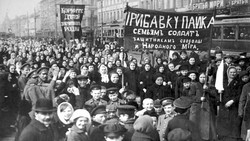
On the 23rd, Mykhail V declared martial law, enforcing a curfew as well as readying the Territorial Defense Force of Khraelyia to put down serious revolts. Due to the increasing tensions between the two sides, then prime minister, Bohdan Kovalenko attempted to meet with revolutionary leaders behind the King's back. On the 25th of January, also known as Saints' Day in Khraelyia, 130 were killed in a protest against the Monarch by the Territorial Defense Service. However, it is quite contentious on whether Mykhail V had actually ordered it or not.
The killings had sparked an even greater response from the populace, as a greater protest begun on the 27th, causing destruction and demanding the end of monarchial rule, and the establishment of democratic rule of law. On February 10th, the royal family fled Khraelyia, seeking refuge in the Secrazchak Empire. The Provisional Congress was officially established on May 20th, turning Khraelyia from a kingdom, to a regency, and finally a republic. Bohdan Kovalenko was then elected as the first president of Khraelyia.
Black Wednesday
| “ | August 3, 1919 SAVINGS LIQUIDATED: HUNDREDS LOSING JOBS This last week, the Prime Minister ordered a forte into an economic reinvigoration plan considering the latest crashes the Khraelyi economic base has suffered. Thousands of workers across the country have been forced out of their jobs, as businesses' savings have been liquidated by the ailing Central Bank. |
” |
| — The Soliriv Post | ||

On the evening of June 19, 1919 the Khraelyi economy entered a recession, as stocks began quickly falling in price. As the economy continued to deteriorate, the government's response was initially limited, and efforts to stimulate the economy were largely ineffective. The lack of effective economic policies, coupled with a decline in international trade and the imposition of protectionist measures, further deepened the crisis. The unemployment rate soared, reaching nearly 25% as citizens across the nation struggled to survive.
Following the 1924 Khraelyi general election, Prime Minister Valentyn Odarchenko began the implementation of a khraelyi rebirth program, which in itself was a program of economic systems, and programs enacted to give jobs in the public works. The programs, as stated by Odarchenko followed the "Three R's", recovery of the economy, relief for the unemployed, and reform of the financial system to prevent another total collapse of the economy.
Invasion of Khraelyia
| “ | May 6th, 1941 Our great nation faces a grave threat, but together, we shall stand unwavering. In these trying times, we will unite and defend our freedom with unwavering resolve. We will overcome this challenge, for the spirit of our nation is unbreakable. |
” |
| — Petar Fidorovic | ||
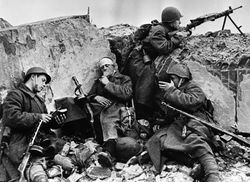
On May 5th, 1941, Khraelyia was invaded by a coalition of nations as part of Operation Kurszan. The operation achieved strategic surprise, with large portions of the Khraelyi army overrun in the initial days of the invasion and had largely captured most of the southwest. By late 1941, Khraelyi forces began offering greater resistance, culminating in the Battle of Krystynopil. By the beginning of 1942, a coalition had formed to assist Khraelyia, sending material, men, and even joining the war on Khraelyia's side. As July of 1942 arrived, the frontline began to stalemate along the Siverschyna River. In August, in an attempt to subvert Khraelyi defense lines, Bosnaeyi-Feodoria was quickly taken over, before officially joining the Axis of Seterran Liberation.
From 1943 to 1944, the frontline remained mostly stagnant, however, an attempted uprising in the city of Vuzlovir quickly caused substantial supply problems for enemy troops, causing a breakthrough under Operation Vidplata in August 1944. Khraelyi forces had managed to reach the prewar border at the town of Zhalanov by March of 1946, followed by a harrowing success in the long-fought for the city of Blahoveshnyi as part of Operation Zhnetsʹ. By August of 1946, Khraelyi forces had reached the newly-built Kálmán Line, causing their renewed offensive to stop.
In April of 1946, multiple factions within the Secrazchak Empire began to enact talks of peace with the Republic of Khraelyia and her allies in the Lisivka Conference. Exiled Secrazchak king, Istvan II was to head a pro-royalist revolt in Kirkassag. On may fifth, the Kirkassag Uprising began, forming a rival government to the hardliners.
Beginning in early 1947, attempts to break the Kálmán Line in northern Kirkassag would result ultimately in the Battle of Tonzheki. In April of 1947, coalition troops had landed south of the Secrazchak capital, opening a secondary front and allowing Khraelyi divisions to begin bypassing defensive lines. In May of 1948, after a year of drastic defenses by Secrazchak troops, the capital of the Secrazchak Empire finally fell. After heavy negotiations, the Treaty of Bochvohrad was signed into effect in July of 1948, effectively ending the Khraelyi theatre.
1995 Constitutional Crisis

In July of 1995, then Khraelyi president Vasyl Yezhov attempted a self-coup, dissolving congress and citing allegations of corruption and inefficiency among the legislative body's members. He then declared a state of emergency and deployed the military to maintain order, sparking outrage and protests across the nation. The opposition, led by prime minister Morozov, accused Yezhov of undermining democracy and trampling on the rule of law. On July 16th, a brutal standoff between protestors and supporters of Morozov, and the Khraelyi military brought the Republic closer to civil war.
On August 3rd, the standoff finally ended when Yezhov finally relinquished control, ending the crisis. He was then formally impeached by the reinstated Congress, being forced to leave office. A snap election was quickly called to fill the void, ending with the inauguration of Myroslav Savchenko as president. A new version of the constitution was written in March of 1996 to remove the loopholes that caused Yezhov to seize power, improving the Khraelyi government and preventing another crisis from happening.
Government and politics
Government
Khraelyia is a federal, parliamentary, representative democracy. All federal legislative power is vested within the Khraelyi Congress, which is further subdivided into the Senate and the National Assembly. The Senate's members are appointed by the governments of the provinces, meanwhile the National Assembly has direct elections using the mixed-member proportional representation system. The Khraelyi government operates under a 1995 rewrite of the Khraelyi constitution. Amendments to the constitution require a two-third majority of both the Senate and National Assembly; the fundamental principles of the constitution, the federal government, and the rule of law are valid in perpetuity.
Executive
The president (currently Viktor Novikov) is the head of state of Khraelyia, and is primarily in control of representative responsibilities. He is elected by a national election, held every four years. The elections for president are indirect, with the votes for president coming from the provinces, whom vote based on percentages of population. The second-highest official in Khraelyi order of precedence is the Holova Senatu (Chairman of the Senate), who is appointed by the Senate, and is responsible for daily oversight. The third-highest official, and the head of government is the Prime Minister, whom is elected alongside the President in elections. Prime minister Olha Polyakova is the current head of government, and exercises executive power through her cabinet.
Since the Republics inception in 1901, the Khraelyi party systems have been dominated mostly by the Social Democratic Party of Khraelyia, Farmer-Labor Party of Khraelyia and the Sovereign Democratic Party. All prime ministers so far elected have been from these majority parties. However, smaller parties such as the New Solidarity Party and the Khraelyi Progressive Caucus have been junior members of coalition governments, predominantly with their larger ideological counterparts. The 1920 general election is famous for electing the only NSP prime minister, Rostyslav Karvatsky.
Legislative
The legislature of Khraelyia is the Congress of Khraelyia, a bicamerial assembly made up of an upper house (Senate) and a lower house (National Assembly). All bills must achieve a supermajority of 2/3 in each chamber, and then be signed into law by the President. The prime minister is the head of government, and resides over the cabinet, and Congress. Each chamber elects a presiding officer from among their membership; the Chairman of the Senate and Speaker of the Assembly, who oversees their business. Per the Khraelyi constitution, the Congress has a range of powers, including, but not limited to: initiate and draft federally binding legislation; control power of the purse; declare war and make peace; approve treaties and international agreements; levy federal taxes and tariffs; regulate commerce between the nation and with foreign nations, to raise and maintain military forces; investigate and audit the federal and judicial branches; impeach executive and judicial officials; and borrow money on the credit of the Federal Republic of Khraelyia.
The Senate is the upper house of Congress, having 57 members, three from every province. Each Senator is elected for a six-year term, with elections held every two years to elect one-third of the Senate. Major powers used by the Senate include; the ability to formally declare war, try cases of impeachment brought by the assembly, and the approval in a supermajority vote of treaties written by the executive branch. The Senate also has a hand in voting for supreme court judges, alongside the National Assembly. The Constitution provides that the prime minister may only "make treaties, subject to the ratification of the Senate" in order to benefit from the Senate's advice and consent and give each senator an equal vote in the process.
The National Assembly, informally referred to simply as the Assembly, is the lower house of Congress, having 500 members, divided among the provinces proportionally by population. Assemblymen are elected for two-year terms, and are available for election every term. Much like the Senate, the National Assembly introduces and votes on bills, however, it can also initiate the process of impeachment on any residing member of the legislature, judicial, and executive branches.
Judicial

The Supreme Court of Khraelyia (Verkhovnyy sud Khraeliya) is the highest court in the nation, also being the court of last resort for certain cases. It has ultimate but discretionary appellate jurisdiction over all federal, provincial, and territorial law that involves an issue in federal law, as well as limited original jurisdiction in a constitutionally limited range of issues. The Supreme Court exercises judicial review, allowing it to affirm or invalidate statutory law or executive regulation based on constitutionality. The Supreme Court consists of 12 associate judges and one supreme court justice. Justices are appointed by the Prime Minister, subject to confirmation by the Senate.
The contemporary Khraelyi judiciary system consists of the following in descending order of ranking: the Supreme Court, the courts of appeal, and the district courts. Courts of appeal are for cases that are from lower civil and district courts, however they do not investigate the facts. Instead, courts of appeal investigate whether or not the law has been fairly and correctly applied by the lower courts.
Law Enforcement and Crime
The are about 19,620 police agencies in Khraelyia, ranging from the local to the federal level. Law in Khraelyia is primarily enforced by local police departments in their municipal or raion jurisdictions. Provincial police departments have authority across the province, and federal organizations such as the MCI have national jurisdiction and specialized duties, such as protecting civil rights, national security and enforcing federal court rulings and federal laws.
As of January 2023, Khraelyia has roughly had the Xth highest incarceration rate in the world, averaging 73 per 100,000 people; and an estimated prison population of 50,690 people.
Khraelyia has a low murder rate, averaging 4.9 murders per 100,000 people in 2021. In 2020, Khraelyia's crime rate hit its lowest since 1987.
Same-sex marriage has been legal in Khraelyia since 1993, whilst LGTBQ+ rights are generally protected.
Political Parties and Elections
Provinces
Khraelyia is a federation, and comprises of nineteen provinces. Each province has its own constitution, and is largely autonomous in regard to their internal organization. People in the provinces are also represented by local elected governments, which are administrative divisions of the provinces subdivided into raions, and further divided into individual municipalities.
Foreign relations
Khraelyia currently has a network of 220 diplomatic missions abroad, and maintains concurrent relations with more than 160 nations worldwide. Khraelyia is the leader of Organization of Free Seterran Nations (OFSN), is currently a member of the World Peace Organization Security Council (WPOSC), the World Bank, and the International Monetary Fund (IMF). Khraelyia has played a central role in the OFSN's doctrine as well as international efforts. Khraelyia, for a long time has held a policy of globalization, with it establishing rather friendly relations with most nations of the world. Since 1952, Khraelyia has been an integral member of the OFSN, and one of the closest allies to the Commonwealth of Vohylt-Tvahorner.
Military
Khraelyia's military, the Territorial Defense Force, is organized into the Khraelyi Armed Forces (the army), Khraelyi Naval Service (the navy), Khraelyi Air Force (the air force), and the Khraelyi National Guard. In absolute terms, Khraelyi expenditure on the military is roughly 640.8 billion dollars, or 2.4% of the GDP. In response to the Shehari Spring, Prime Minister Olha Polyakova declared in March of 2022 that the Khraelyi military budget would rise to 3% of the GDP by FY2031, or roughly a 166.6 billion dollar increase.
As of January 2020, the Defense Force has 1,469,000 active personnel, with 800,000 in reserve. Three thousand of these active soldiers are stationed in Mirasan, which has been in a civil war since 2009. Until 1988, military service was compulsory for men at age 20, before being replaced with voluntary service. As of 1997, women have been allowed to serve in all major functions of the military. The Khraelyi military has begun a program to expand the military's active duty soldiers to 1,600,000 by 2025, noting major changes in global tensions.
In peacetime, the military is headed by the Minister of Defense, however in a state of defense, the President would become commander-in-chief of the armed forces. The role of the armed forces, as described in the constitution, is for a doctrine of deterrence and armed neutrality.
Khraelyia has multiple major military industries, and one of the largest aerospace sectors in the world. The country has produced equipment such as the world-renowned ST.84 main battle tank, the VSh.97 jet fighter, as well as massive naval vessels such as the KNS Slava. Among the largest Khraelyi defense manufacturers, are Yosyp-Kolisnyk, Central Dynamics, and the Alapayiv Arsenal.
Economy
| Economic indicators | ||
|---|---|---|
| Nominal GDP | $29.681 trillion (Q3 2024) | |
| Real GDP growth | 5.3% (Q3 2024) | |
| CPI inflation | 1.45% (September 2024) | |
| Employment-to-population ratio | 62.3% (September 2024) | |
| Unemployment | 3.8% (September 2024) | |
| Labor force participation rate | 65.4% (September 2024) | |
| Total public debt | $8.192 trillion (27.6% of GDP) (September 2024) | |
| Household net worth | $163.517 trillion (Q3 2024) | |

Khraelyia has a social market economy with a highly skilled labor force and low corruption. Khraelyia's high technology sector is a world leader in terms of innovation. It is the world's top exporter and importer, also with the largest economy on the planet, at 26.891T in 2020. It's GDP per capita measured by purchasing power parity has been measured to be $64,964, ranking far higher than the international average. The service sector of Khraelyia contributes approximately 65% of the GDP, with industry at 33%, and agriculture at 2%. Khraelyia's unemployment rate, as gathered by the Ministry of Labor in 2020 was 3.6%, a historic low.
The top ten exports of Khraelyia are vehicles, machinery, trains, chemical goods, synthetic oil and subsequent products, electrical equipment, pharmaceuticals, food products, rubbers and plastics, and basic metals.

Being home to the modern train, Khraelyia has been one of the largest investors and producers of trains, as well as other types of transportation such as vehicles and public transportation such as busses and trams. Khraelyia is home to the Mykolaiv Automotive Group, the world's second largest automotive producer by vehicle production and sales in 2020, and is the second-largest exporter of vehicles in the world.
Of the world's top five hundred stock-market-listed companies measured by revenue in 2018, the Global 500, 135 are headquartered in Khraelyia. Well-known brands include KMG, Belyakov, KhASK, MP, MAG, Central Dynamics, as well as dozens of others. Soliriv, as well as multiple smaller cities are prime hubs for startup companies.
Infrastructure
Centered in south-central Verdantis, the Tserov Basin of Khraelyia has become one of the most vital hubs of commerce in the world. Its road networks, including the National Highways, are some of the densest in the world. Khraelyia's National Railway Network serves numerous cities within Khraelyia, as well as some cities abroad, such as Tonzheki in Kirkassag. The largest airports in Khraelyia are Bochvohrad Airport, Lisivka Airport, and Noriyiv Airport. The port of Lisivka is one of the top ten largest container ports in the world.
In 2022, Khraelyia was the second-largest consumer of energy in the world. Khraelyia is the largest user of nuclear power, having 56 NPPs as of 2019. Khraelyia gets approximately 83% of energy from fossil fuels, with 36% of that being from petrol, and 16.4% being from natural gasses. Renewable energy has slowly been growing in the country, especially with renewed acts to curb global warming, with three NPPs scheduled to close in 2025.
Tourism
Khraelyia is the third-most visited country as of 2020, with 46.7 million international tourists. Domestic, as well as international travel from Khraelyia combined contribute roughly 248 billion dollars to the Khraelyi economy. Including indirect and induced impacts, the tourist industry of Khraelyia supports roughly 10.2 million jobs.
Khraelyia's most visited locations and popular landmarks include the Bochvohrad Arch, Mount Zhalyarov, remnants of the Kálmán Line, the Serene House of Khraelyia, and the Artemenkohrad Fortress.
During the 20th century, with the rise of the automobile and air travel from 1920-1970, people across the world began to travel farther, further contributing to tourism within Khraelyia. Purchases of travel and tourism-related goods and services by international visitors traveling in Khraelyia totaled 11.6 billion during February 2014.
Science and technology
Science has held a dominant point within Khraelyia, since the formation of the country and even before the Khraelyi Confederation. Khraelyia has been a massive contributor toward sciences, including improving human life as well as overall technological improvements and advances. The University of Soliriv, one of the oldest universities within Khraelyia, is regarded as one of the most important institutions worldwide.
Khraelyia was one of the first nations to develop nuclear weapons, with the first tests taking place in 1946, under Operation Vohnyana kulya during the invasion. Although none were used, they were used as a deterrent throughout the Global Freeze.
During the Global Freeze, Khraelyi engineers raced against Kardovij engineers from the UFRR to be the first to attempt to explore the stars. The first attempts, being the Starfire Program, a collaboration with the Commonwealth and the Khraelyi National Aeronautic and Interstellar Administration (NAIA), resulted in cosmonaut Danylo Ponomarenko and Vohylt sternsegler Wilhelm Ackermann being the first men in space in 1963, and the Lunarri landing in 1970.
Modern advances in the medical field have resulted in breakthroughs in CRISPR, advances in Telomere research, and stem cell research. Khraelyia has often been said as being "on the precipice of understanding the human genome", with the possibilities of being able to genetically modify humans within the coming decades.
Income, poverty, and wealth
The Khraelyi labour force is estimated to be 62.3% of the population, or 227.48 million workers, with a participation rate of 65.4%. The leading field of private employment in Khraelyia is service-providing work, with a total worker count averaging 94.5 million. A quarter of Khraelyi workers are unionized, the largest union being the Organization for the Protection of Labour (OPL). Workers often have extended parental leave, paid vacation time, or sick leave, even at the federal level.
The federal minimum wage of Khraelyia is 13.50 an hour, one of the highest in the world, regulating based on annual inflation. Provincial minimum wages often fluctuate around this level, with the highest being in Sarakhiv Province, at 15.75 an hour. Overtime is paid at time-and-a-half for non-exempt workers and employees for all hours work in excess of 40 hours in a workweek or 8 hours in a workday. Time-and-a-half must also be paid for workers who work on federal holidays.
Unemployment within Khraelyia as of September 2020 is rated at 3.6%. It has the Xth highest median gross household income in the world, at $53,650 in 2015. The government offers substantial aid, benefits, and services to eligible citizens, as well as authorized foreign employees, which is further supplemented by provincial or raion-based unemployment insurance programs.
An approximated 13.4% of citizens live below the relative poverty line, which has been set by the Ministry of Finance at $23,000.
Geography
Climate
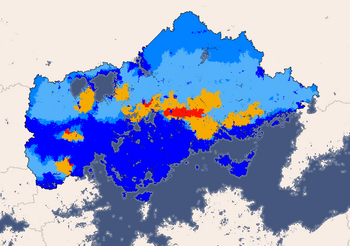
With its large size and geographic variability, Khraelyia includes most climate types.
Location and Borders
All of Khraelyia's territory is situated in north and central Verdantis. It's bordered by the Grindgat Sea to the south, with the Bay of Batapovets to the southeast. To the west are the famous Blahoveshnyi Mountains, acting as a natural fortification. To the northwest is the vast Sarakhiv Mountains, with the Central Verdantis Plains through the north and northeast. Its land borders include the Sofíae Commonwealth to the north, the Republic of Oselia to the east, the twin monarchies to the west, and Republic of Chzeknye and Kirkassag Republic to the southwest. Khraelyia's land borders are largely formed by the various features across the land, notably including the Sarakhiv mountains, the Varzuga River, which denotes the Kirkassag-Khraelyi border, and the Oseli Canal, which partially determines the Oseli-Khraelyi border.
Khraelyia covers a total of 9,336,907 square kilometers (3,605,000 square miles), third largest on the continent, following the Sofíae Commonwealth and Kardovija. Khraelyia includes a vast arrange of landscapes, from mountain ranges, to plains, steppes, such as the Sterlikhove Steppe, and hills.
Khraelyia's exclusive economic zone is estimated to roughly be 650,298 square kilometers.
Biodiversity

Khraelyia ranks third in the world in biodiversity, and is one of the fifteen Megadiverse nations. With over 220,000 species recorded, Khraelyia hosts 13% of the worlds' biodiversity. Khraelyia ranks third in biodiversity of mammals, with a lower diversity of reptiles and amphibians. Khraelyia is considered the third country in the world in ecosystems, and fifth overall in species. Roughly 2700 species are protected by Khraelyi legislation.
Some of Khraelyia's most famous species include the Khraelyi rainforest jaguar, the emerald-throat hummingbird, the Khraelyi orchid mantis, the rainbow-feathered quetzel, the short-snouted simogile, and the golden-flecked tree frog.
Environment
Khraelyia was one of the first countries to create an environment ministry, in 1985. Although Khraelyia is dubbed one of the most industrialized countries in the world, it is only 7th in carbon emissions, behind nations such as Kardovija. This is due to its heavy nuclear efforts, mostly sparked from limited oil embargoes from the Shehari nations. According to the 2020 Environmental Performance Index, collected by Bochvohrad and Skoria Bay, Khraelyia was sixth-most conscious about the environment, behind nations like Helstorig and Kirkassig.
Like all WPO members, Khraelyia agreed to cut carbon emissions by 20% of 2005 metrics by 2025. Compared to most nations, Khraelyia has cut emissions by 8% as of 2019, severely behind what was requested. The country planned to place a carbon tax at 15 dollars in 2019, however no official statements were made, as well as the worries of burdening Khraelyi businesses from additional expenses.
Forests, as well as rainforests account for roughly 34.5% of Khraelyia's land area—the second largest in Verdantis. This accounts for an estimated increase of roughly 3% since 2000. Khraelyi forests are some of the most diverse environments in the world, with some estimated to house over 200 unique species. In the 2020 Forest Landscape Integrity Index, Khraelyia had a mean score of 7.14/10, ranking it X out of X countries. Khraelyia has 70 national parks, and well over three hundred natural parks, with the most recent being the Lisivka Gap National Park in 2011.
Demographics
With a population of 362.2 million in 2020 according to the 2020 Khraelyi National Census, Khraelyia is the fifth-most populous country in the world, and the second most populous country in Verdantis. Khraelyia's population density as of 2020 stands at 38.8 inhabitants per square kilometer. The fertility rate within Khraelyia is 1.66 births per woman (using statistics from 2022), below the international average of 2.2 births per woman. Khraelyia's population has a median age of 40.6 years old, ranking it within the top forty nations.
The majority of Khraelyia within the 2020 Khraelyi National Census, an approximated 99.7% identified as Khraelyi. Within Chapatove Province, there is a minority of Reanhark peoples, whom themselves make up .3% of the population of the Chapatove Islands.
Khraelyia is the largest immigration destination in Seterra. Refugee Crises have been an influential factor in migrant population within Khraelyia, including the Shehari Spring and the Goriyar Political Crisis. In 2022, an approximated 15.4% of the population (54.3 million) noted a partial migratory background.
Khraelyia has a number of large metropolitan areas. There are roughly 543 MSRs (Metropolitan Statistical Regions) within Khraelyia, with the largest being the Bochvohrad Statistical Region. Khraelyia's Capital, Soliriv, is regarded as the ninth-largest city in Khraelyia.
Religion
Khraelyia has one of the largest populations of Altralists worldwide. A 2021 survey conducted by the Federal Ministry of the Interior concluded that 70% of Khraelyi citizens declared themselves religious, with 30% stating they followed no religion. The level of religiosity in Khraelyia was reported to be the highest within southwest Khraelyia (94%), and it being the lowest in northern Khraelyia (43%).
In 2020, 67.8% of Khraelyi citizens were Altralists; out of which 49.2% declared themselves orthodox, and 18.6% declaring themself reformist., and 2% were following Shehari religions. According to the Federal Ministry of the Interior, 55% of Astralists belonged to the Khraelyi Orthodox Altralist Church.
Reformist Altralism is a growing religion within Khraelyia, whom made of 15.5% of the population in 2010, but made up 18.6% in 2020.
Language
According to the Osnovna norma prava, Khraelyi is the offical state language. Alongside Khraelyi, Reanhark is recognized as well, despite having a dwindling amount of speakers. Reanhark was added as a state language in 2013, as multiple parties as well as members of government spoke of preserving the language for future generations.
In 96% of the country, Khraelyi is the primary language used. In eastern Khraelyia, some raions have listed the Oseli dialect of Khraelyi as a regional language, as well as the regional language of the Chapatove Province. In South-west Khraelyia, there is a small minority of Kirkassag speakers, a leftover from attempted settlement by the Secrazchak Empire during the invasion.
Urbanisation
Roughly 60% of Khraelyi citizens live in urban areas, including suburbs; about half of these residents live in communities larger than 50,000. In 2022, 271 incorporated municipalities recorded populations of over 100,000, twenty-seven cities reported having populations of over one million, and thirteen cities (Bochvohrad, Yurivka, Beletiurynsk, Artemenkohrad, Lisivka, Noriyiv, Nalzke, Selidivka, Soliriv, Kadiivka, Havrylivka, Pyatyvoda, and Kopanivka.) reported populations exceeding two million. Of these, Bochvohrad, Yurivka, Beletiurynsk, Artemenkohrad, and Lisivka reported populations exceeding five million.
| Largest Metropolitan Areas in Khraelyia | |||||||||||
|---|---|---|---|---|---|---|---|---|---|---|---|
| Rank | City | Province | Pop. | Rank | City | Province | Pop. |
| |||
| 1 | Bochvohrad | Bochvohrad Municipality | 27,178,945 | 11 | Havrylivka | Arzashivsk Province | 2,470,814 | ||||
| 2 | Yurivka | Yurivka Province | 13,589,473 | 12 | Pyatyvoda | Pyatyvoda Province | 2,264,913 | ||||
| 3 | Beletiurynsk | Novovulivka Province | 9,059,649 | 13 | Kopanivka | Novovulivka Province | 2,090,689 | ||||
| 4 | Artemenkohrad | Soliriv Province | 6,794,737 | 14 | Arzashivsk | Arzashivsk Province | 1,941,354 | ||||
| 5 | Lisivka | Lisivka Province | 5,435,789 | 15 | Cherezyne | Lisivka Province | 1,811,930 | ||||
| 6 | Noriyiv | Sterlikhove Province | 4,529,825 | 16 | Sarakhiv | Sarakhiv Province | 1,698,685 | ||||
| 7 | Nalzke | Novovulivka Province | 3,882,707 | 17 | Blahoveshnyi | Blahoveshnyi Province | 1,598,762 | ||||
| 8 | Selidivka | Arzashivsk Province | 3,397,369 | 18 | Lisokyn | Suylivka Province | 1,509,942 | ||||
| 9 | Soliriv | Soliriv Municipality | 3,019,883 | 19 | Lisovartivsk | Lisovartivsk Province | 1,430,471 | ||||
| 10 | Kadiivka | Kadiivka Province | 2,717,895 | 20 | Vidnorohrad | Yurivka Province | 1,358,948 | ||||
Health
The Khraelyi health care system is one of universal health care, largely financed by government health insurance. In a 2010 study of national health care systems, Khraelyia was ranked among the top 15 in health care quality. In 2018, Khraelyia spent roughly 20% of the GDP on health care, equating to roughly 4.6 trillion. Within this, approximately 75% of all health expenditures are covered by government-funded agencies.
Care is generally free for citizens suffering from chronic diseases and conditions, such as cancer, cystic fibrosis, HIV/AIDs, and Alzheimer's. The average life expectancy for men is 81.1 years, whilst for women the average life expectancy is 87 years. There are roughly 3.1 physicians per 1000 citizens in Khraelyia, and the average health care cost per capita was $4,821 in 2010.
Education

Pre-tertiary education is arranged at the raion level. Roughly 2.8% of students are enrolled in private schools (usually specialist schools and foreign-exchange programs). Formal education is started at the age of six, with primary education taking eight years, and lower secondary education taking four years.
Khraelyia's national education curriculum is set by the Ministry of Education and Culture, as well as school boards across Khraelyia. Education is compulsory from ages seven to eighteen. After lower secondary school, graduates may apply to colleges, universities, or trade schools. These trade schools include vocational education. Approximately 35% of students choose this path after lower secondary school.
In tertiary education, there are two major forms that can be found: the profession-oriented polytechnical schools, which include trade schools, as well as research-oriented universities. Education is free, and living expenses are majorly paid for by the government through student benefits. There are over 4000 universities in Khraelyia, with 19 Khraelyi System universities, one for every province. Many of the world's top universities, as listed by various ranking organizations, are in Khraelyia, including 17 of the top 25.
Around a third of citizens in Khraelyia have a tertiary degree, more than most countries other than Remania (35%), Nurmandria (41%), and Suedval (34%). In addition, 38% of Khraelyia's population has a college degree, which is ranked among the highest in the world. Of citizens 25 and older, 86.5% earned a primary education degree, 52.6% attended some college, 27.2% earned a bachelor's degree, and 9.6% earned graduate degrees.
Culture
Literature and Philosophy

Khraelyi literature can be traced back to ancient Khraelyi tribes, early kingdoms, as well as the roaming Carxaghi mechants. Well-known Khraelyi authors include Havrylo Yushchenko, Oksana Ivanchenka, Feodosij Antonenko, and Mykyta Zinchenko. Yushchenko published the first Khraelyi dictionary in 1438.
Influential 20th century authors from Khraelyia include Khrystyna Rudenka, Josyp Voloshyn, Yukhym Korniyenko, and Serhij Zakharchenko. The Khraelyi book market is the largest in the world, with thousands of books passing through it. The Lisivka Book Fair is the largest and the most important center for international deals and trading, with a tradition lasting nearly 200 years.
Khraelyi philosophy has been historically significant, with Yuriiy Onyschenko's contributions to modern realism and rationalism; the age of modern enlightenment by philosophers in the south also had a profound impact on modern Khraelyia, with philosophers beginning to tread on the philosophy of human rights.
Mass media
Mass media in Khraelyia is broadly uncensored, with significant protections to the freedom of speech implemented by the government. The largest public broadcasters within Khraelyia are the National Public Radio of Khraelyia (NPR), Federal Broadcasting Service (FBS), and Khraelyi Broadcasting Company (KBC). The three main broadcasters are all commercial entities. Cable television offers hundreds of channels, and caters to various niches, such as Reality TV. As of 2020, 81% of Khraelyi citizens over the age of 13 listen to broadcast radio, with 42% of that listening to podcasts.
Globally recognized newspapers within Khraelyia include Khraelyia Daily, The Noriyiv Times, and The Soliriv Post. With few exceptions, all newspapers are owned by private companies which own and run hundreds of newspapers, or the smaller publications that often run a handful of papers. Major cities within Khraelyia often have alternate newspapers, which complement the major papers.
Music

Music is a major part of Khraelyi culture, with a long history and many influences. From traditional folk music to classical and modern rock, Khraelyia has produced a wide variety of globally-recognized artists such as Mykhail Bondar, and the Korolivsʹki sestry (Royal Sisters). Elements from Khraelyi folk music has made its' way into worldwide depictions of music, and ran the forefront of modern rock music and folk country.
Elements from folk musics such as hymns as well as early blues were adopted, and turned into popular genres with worldwide audiences. Rock and Roll grew from earlier Deiric attempts toward a more "pop-oriented" style of music in the 50s. The musical forms of punk and hip-hop originated in Khraelyia, coined by the artist band Rogue Raiders in 1972.
The Federal Republic of Khraelyia has the world's largest music market with a total retail value of $16.3 billion in 2020. Most of the world's major record labels are based in Khraelyia; represented by the Khraelyi Recording Industry. Mid-20th century pop-stars such as Volodomyr Kolesnik and Olha Kovala became major celebrities and best-selling artists.
Visual art, design, and architecture
In the visual arts, the Siverschyna River Institute was fundamental toward the 19th century idea of realist art. The 1912 Roadshow Expedition in Selidivka was instrumental toward further showcasing Southern Verdantisan art, shocking the public and utterly transforming the art scene of Khraelyia.
Artists such as Aleksander Onopka as well as Boryslav Ryabets experimented with new, and individualistic styles which would become known as Khraelyi Modernist Realism. Major artistic movements such as the abstract expressionism of Oleksandra Dumitrashka and the pop art of foreign-born artist Lanbeorht Godwin were largely developed in Khraelyia. Significant photographers include Feodor Blyznyuk, Leonid Holovaty, and Vsevolod Elishchuk.
Architectural contributions from Khraelyia include the Classic Khraelyi style, as well as the "import" of styles from across the globe. Brick gothic architecture evolved within central Khraelyia, having originated within the South-Grindgat coasts, before migrating northward. When industrialization swept through Verdantis, Classic art as well as historic art gained a significant foothold in Khraelyia.
Fashion

Khraelyia, as well as the UFRR account for the vast majority of apparel worldwide. Besides professional business attire, Khraelyi fashion is eclectic and progressively informal. While Khraelyi citizens' roots are reflected in their clothing, modern clothing such as sneakers, jeans, T-shirts, and baseball caps have become widely centered in modern Khraelyi styles.
A multitude of designer brands are headquartered within Soliriv and Bochvohrad. Labels cater to niche markets, such as teenagers and young adults. There has been a recent trend supporting sustainable clothing within Khraelyia, and more widely within northern Verdantis. Soliriv Fashion Week is one of the most influential fashion weeks in the world, and occurs twice annually.
Cuisine

Khraelyi cuisine varies from region to region, with most sharing some culinary similarities between one other, including the Eastern regions of Khraelyia and the northern part of Oselia. International varieties of food, such as borscht, pizza, noodles, and international culinary treats are popular throughout the country.
Bread is a significant part of Khraelyi culture, with thousands of bakeries across the country producing hundreds of varieties of breads, rolls, and pastries. Khraelyi cheeses often account for 40% of the worlds production annually. A vast majority of Khraelyia's annual meat production is Chicken, followed by pork and beef.
The national alcoholic drink of Khraelyia is whiskey. Khraelyia's beer consumption per person stands at 73 litres in 2015. Wine and Beer have had growing popularity within the Country, with wineshops opening up across the south.
Khraelyia's restaurant industry has been reported to be worth upwards of 912 billion dollars in 2018, while also employing 16 million, representing 8% of the workforce on its own. It is Khraelyia's second largest private employer, and the third largest overall.
Sports

The most popular spectator sports within Khraelyia are volleyball, gridiron, basketball, and ice hockey. Whilst most sports are of foreign invention, basketball was invented in Khraelyia, and has become popular worldwide. The market for professional sports within Khraelyia was approximately $76 million as of July 2015, larger than most Verdantis nations.
Ice hockey is by far the most watched sport within Khraelyia by a magnitude of measures, followed by basketball and volleyball. The Khraelyi National League of Hockey (KNLH) has the highest attendance of any sports league in the world. The most popular individual sports within Khraelyia are auto racing, tennis, and shooting.
Multiple International Athletic Games have been played in Khraelyia, including the 1974, 2002, and 2014 games. Khraelyia is also slotted to hold the 2026 games, predominantly in Dovhoshykha Province.
See Also
